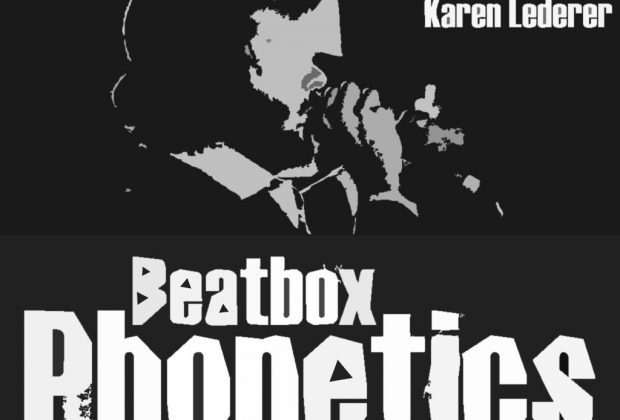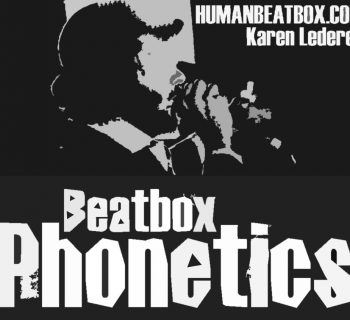by Karen Lederer
[READ PART 4 : THE ELECTRONIC AND VOCAL PRODUCTION OF SOUND]
The Acoustic and Auditory Phonetics of Human Beatboxing
Part 5 : Methodology
In Part 5 of Karen Lederer's series on the Phonetics of Beatboxing, she introduces the experimental comparison of vocally and electronically produced sounds.
5.0 Methodology: Structure of experiment
To ascertain the accuracy with which a beatboxer recreates the sounds of a drum machine, a selection of 3 percussion sounds was chosen for comparison. Beatboxed sounds and corresponding electronic ones were recorded to Speech Station 2 where spectrograms, waveforms and power spectrums of each were analysed. The durations, frequencies, rates of fade, amplitude rise times and general energy patterns of each sound were measured, tabulated where possible and then compared.
Sounds are considered separately at first as each one requires different measurements and comparisons. General comparisons of electronic and beatboxed sounds are then made and general conclusions drawn in a summary of findings.
Beatboxing samples were downloaded from www.humanbeatbox.com as MP4 files. Initially these were not compatible with Speech Station 2 so in order to be read, they were converted to wav files using Winamp. They were then transferred to Speech Station 2 without interference so the sounds are of original quality.
The TR808 samples were transferred directly to Speech Station 2 from Michael Fischer’s website http://tr-808.com/ (ed. now deprecated, TyTe, 2014).
5.1 Choice of data
A huge and almost infinite number of sounds are used in beatboxing by each different beatboxer and, as for the sounds of speech, there are simply too many to allow analysis of them all.
Each sound in beatboxing is created in its own unique way and a single beatboxer may produce any given sound differently each time he makes it. This study analyses three unique productions of beatboxed sounds by a single artist.
With kind permission of Gavin Tyte, his beatboxing sounds were used in this study. TyTe is a professional beatboxer, teacher of beatboxing and owner of www.humanbeatbox.com. The sounds analysed in this study were obtained from his beatbox tutorials at www.humanbeatbox.com. As well as providing samples, they also provide instruction as to how to create each sound. TyTe has also coined names for beatboxing sounds which indicate which (if any) drum machine sound they imitate.
Originally, six of the most commonly used and popular sounds were chosen for comparison: Six sounds were analysed but in order to analyse the sounds in enough detail, the number of sounds had to be reduced to three. The clave click, the kick drum and the open hi-hat were selected as they provide examples of beatboxed sounds on different airstream mechanisms and different techniques can be investigated.
To compare the beatboxed sounds with electronically produced ones, corresponding sounds were obtained from samples of a TR808 Rhythm Composer at http://tr-808.com/ (ed. no longer available, 2014). The TR808 is capable of producing sixteen different instrument sounds. Each sound can be further modified by altering the tuning and/or decay settings, allowing hundreds of sounds to be created , however only one sound for each beatboxing sound can be chosen for comparison.
When there was a choice of electronic sounds, an auditory judgement was made and the TR808 sample that sounded most similar to the beatboxed sound was then chosen for analysis.
The sounds chosen for comparison are displayed in Table 5.1, below.
Table 5.1. Beatboxed and drum machine sounds chosen for comparison.
| Beatboxed sounds (Gavin Tyte) | Drum machine sounds (Roland TR 808) |
|---|---|
| Classic Kick { Bh } | |
| Click { + } | |
| Open Hi-hat { ts } |
|
Note: For an explanation of filenames, tuning and decay figures please see Appendix 1 : Roland TR 808 Sounds.
5.2 Technical limitations of data collected
A problem that occurred in comparing beatboxed sounds with drum machine sounds is that the sampling rates for each were different. Frequencies of up to 20kHz could be seen on the drum machine sounds but for the beatboxed sounds, frequencies of only 6-7kHz were displayed. In an attempt to rectify this problem, both sets of data were played through a set of speakers and then re-recorded through a free field at a common sampling rate of 44.1kHz. This allowed a direct comparison but in all re-recorded sounds there was a band of energy at around 4,000 Hz. This was due to the air-conditioning in the recording room and interfered with the analysis and comparison of the sounds. The high sampling rates were therefore rendered unusable. Instead, the sounds had to be compared at different sampling rates and these differences borne in mind when making comparisons.
In both human beatboxing and drum machine sounds, frequencies above those displayed on the spectrograms are present. The spectrograms only allow comparison of the sounds below 6,000Hz, but there may be significant features of the sounds that occur in high frequencies not visible at the available sampling rates. The comparison of the sounds in this study is therefore limited, however many important similarities and differences between vocally and electronically produced sounds are still evident.





